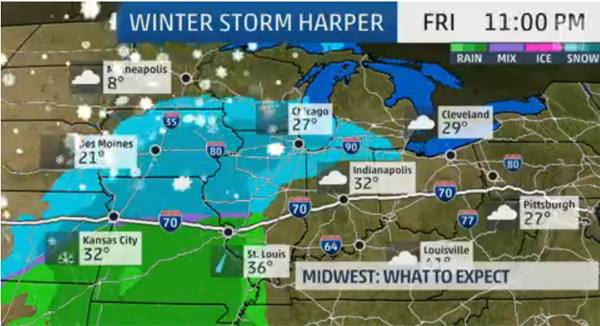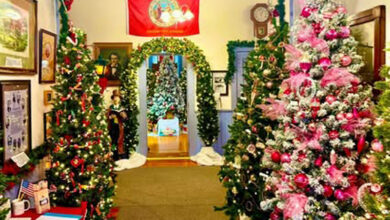Weekend winter storm forecast for Northeast Kansas

A winter storm system is forecast to descend across Kansas Friday and Saturday with snowfall averaging between one to four inches in most regions of the state. Heavier snowfall is forecast for far northeast Kansas. Projections are around 1-2″ for Emporia, 2-4″ near Manhattan/Topeka and 4-7″ closer to the Nebraska border. Gusty winds up to 40 mph, cold temperatures and very low wind chills are expected across much of the state. Slick roads are possible with low visibility at times. Temperatures varying above and below freezing means icy roads are a distinct possibility.
Sunday should be partly cloudy with no more precipitation likely, but very cold with winds 5-15 mph, and a high of only about 20-25 degrees.
The Kansas Division of Emergency Management will activate the State Emergency Operations Center in Topeka to an enhanced steady state to monitor weather conditions and stand by to receive any requests for state assistance.
“Kansans are urged to change or delay their travel plans in these areas until the storm moves through,” said Jonathan York, Response and Recovery Branch director. “If you plan to travel, use caution and make sure your car emergency kit is stocked.”
Winter road conditions are accessible by dialing 5-1-1 from your mobile phone anywhere in Kansas; outside Kansas call 1-866-511-5368 (KDOT). Road conditions many also be viewed on the Kansas Department of Transportation web site at http://kandrive.org.
If you must travel, be sure your car’s gas tank is full and you have an emergency kit. Vehicle emergency kits should include blankets, flashlights, batteries, a cell phone charger, hand-warmers, high-energy food snacks, bottled water, necessary medications, a snow shovel, flares and other emergency supplies. Make sure your cell phone is charged and someone is aware of your itinerary, including expected time of arrival.
For a complete list of items for an emergency kit, go to www.ready.gov.
Information on winter driving tips is available from the Kansas Highway Patrol at http://www.kansashighwaypatrol.org/259/Winter-Driving-Tips. You can also follow the Kansas Highway Patrol on Facebook and Twitter at www.kansashighwaypatrol.org.
COLD WEATHER TIPS FOR PETS
Know the limits: Just like people, pets’ cold tolerance can vary from pet to pet based on their coat, body fat stores, activity level, and health. Be aware of your pet’s tolerance for cold weather, and adjust accordingly.
- Stay inside. Cats and dogs should be kept inside during cold weather.
- Make some noise: A warm vehicle engine can be an appealing heat source for outdoor and feral cats, but it’s deadly. Check underneath your car, bang on the hood, and honk the horn before starting the engine to encourage feline hitchhikers to abandon their roost under the hood.
- Check the paws: Check your dog’s paws frequently for signs of cold-weather injury or damage, such as cracked paw pads or bleeding.
- Play dress-up: If your dog has a short coat or seems bothered by the cold weather, consider a sweater or dog coat.
- Wipe down: During walks, your dog’s feet, legs and belly may pick up deicers, antifreeze, or other chemicals that could be toxic. When you get back inside, wipe down (or wash) your pet’s feet, legs and belly to remove these chemicals and reduce the risk that your dog will be poisoned after (s)he licks them off of his/her feet or fur. Consider using pet-safe deicers on your property to protect your pets and the others in your neighborhood.
- Stay home: Hot cars are a known threat to pets, but cold cars also pose significant risk to your pet’s health. You’re already familiar with how a car can rapidly cool down in cold weather; it becomes like a refrigerator, and can rapidly chill your pet. Pets that are young, old, ill, or thin are particularly susceptible to cold environments and should never be left in cold cars. Limit car travel to only that which is necessary, and don’t leave your pet unattended in the vehicle.
- Prevent poisoning: Clean up any antifreeze spills quickly, as even small amounts of antifreeze can be deadly.
- Avoid ice: When walking your dog, stay away from frozen ponds, lakes and other water. You don’t know if the ice will support your dog’s weight, and if your dog breaks through the ice it could be deadly.
- Provide shelter: We don’t recommend keeping any pet outside for long periods of time, but if you are unable to keep your dog inside during cold weather, provide him/her with a warm, solid shelter against wind. Make sure that they have unlimited access to fresh, non-frozen water (by changing the water frequently or using a pet-safe, heated water bowl). The floor of the shelter should be off of the ground (to minimize heat loss into the ground) and the bedding should be thick, dry and changed regularly to provide a warm, dry environment. The door to the shelter should be positioned away from prevailing winds. Space heaters and heat lamps should be avoided because of the risk of burns or fire. Heated pet mats should also be used with caution because they are still capable of causing burns.
For more information on pet care go to https://www.avma.org/public/PetCare/Pages/Cold-weather-pet-safety.aspx







